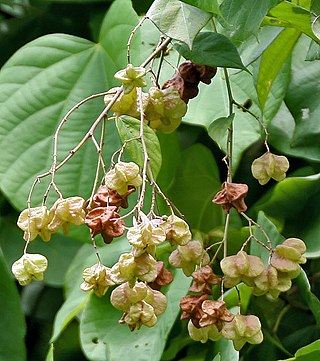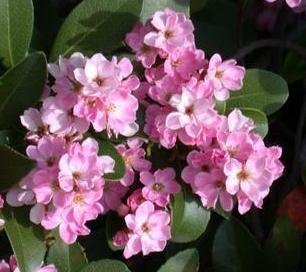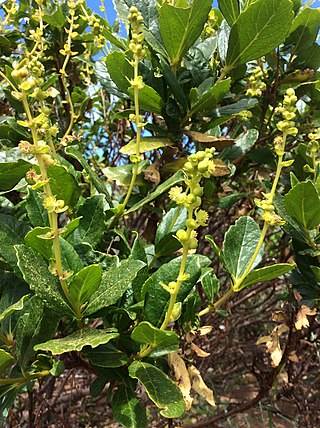
Codiaeum variegatum is a species of Codiaeum, a genus of flowering plants, in the Euphorbiaceae. Initially described by Carl Linnaeus in 1753, it is native to Australasia and Oceania, from Malaysia and Indonesia in the north through northeastern Australia, as well as many Southeast Asian and South Pacific islands, growing in open forests and scrub.

Kleinhovia is a monotypic genus of plants in the cotton, hibiscus and cacao family Malvaceae. The sole species in the genus is Kleinhovia hospita, commonly known as guest tree, an evergreen tree native to Indonesia, Malaysia and other parts of tropical Asia and the Pacific.

Rhaphiolepis indica, the Indian hawthorn, India hawthorn or Hong Kong hawthorn is an evergreen shrub in the family Rosaceae.
Ocotea cuneifolia is a species of tree in the family Lauraceae that is native to Colombia, Ecuador, and Peru.

Eriogonum flavum is a species of wild buckwheat.

Adriana quadripartita, the bitter bush, is a shrub in the family Euphorbiaceae. The species, which is endemic to southern Australia, has an erect open habit, growing to between 0.5 and 3 metres or more high.

Pseuderanthemum variabile, commonly known as pastel flower or love flower in its native range, or night and afternoon in the USA, is a small perennial herb in the family Acanthaceae which is native to Australia, Papua New Guinea and New Caledonia. It can be an unwelcome nuisance in orchid nurseries in Australia.

Phyllanthus microcladus, commonly known as the brush sauropus or small-leaved Phyllanthus, is a plant in the family Phyllanthaceae found in tropical and sub tropical areas of eastern Queensland and northeastern New South Wales in Australia. It is listed as endangered in New South Wales, but in Queensland it is assessed as least concern. It occurs by streams in rainforest, from near Grafton northwards to around Cairns.
Petenaea cordata was first described in Elaeocarpaceae and later placed in Tiliaceae, but most authors have been uncertain about its familial affinities. It was considered a taxon incertae sedis in the Angiosperm Phylogeny Group classification. Molecular analyses based on a recent collection from Guatemala indicate a distant, weakly supported sister-group relationship to the African genus Gerrardina. As no obvious synapomorphies exist for Gerrardina and Petenaea, the new monogeneric family Petenaeaceae was proposed. The polymorphic order Huerteales now comprises four small families: Dipentodontaceae, Gerrardinaceae, Petenaeaceae and Tapisciaceae. Petenaea cordata is the only species in the genus Petenaea.
Buddleja stachyoides is the most widespread member of the genus in South America, endemic to woodland edges, roadsides and riversides in Argentina, Brazil, Bolivia, Paraguay, and Uruguay. Introduced to the UK as B. australis in 1822, when the Royal Botanic Garden Edinburgh grew it from seed received from a Russian source, the plant was described and renamed B. stachyoides by Chamisso and von Schlechtendal in 1827.
Dodecadenia is a botanical genus of flowering plants in the family Lauraceae. It contains a single species, Dodecadenia grandiflora. It is present from central Asia, to Himalayas and India. It is present in tropical and subtropical montane rainforest, laurel forest, in the weed-tree forests in valleys, mixed forests of coniferous and deciduous broad-leaved trees, Tsuga forests; 2,000–2,600 metres (6,600–8,500 ft) in China in provinces of Sichuan, Xizang, Yunnan, and countries of Bhutan, India, Myanmar, and Nepal.

Trema tomentosum, also known as T. tomentosa and commonly called poison peach, is a shrub or tree in the family Cannabaceae native to the Indian subcontinent, south east Asia, through the islands of the south west Pacific, and the east coast and northern half of Australia.

Prunus himalayana, called jyokun shin in Tibetan and 喜马拉雅臭樱 in Chinese, is a species of Prunus native to Nepal, Bhutan, Sikkim and Tibet. It prefers to grow 2,800 to 4,200 m above sea level in the Himalayas. As Maddenia himalaica it was the type species for the now unrecognized genus Maddenia.

Bertya opponens is a shrub/tree in the family Euphorbiaceae, native to Australia and found in New South Wales and Queensland. It is found on ridges amongst mallee in shallow soils. It flowers in July and August.
Salix balfouriana is a shrub or small tree from the genus of willow (Salix) with reddish black and tomentose hairy young twigs and up to 8 leaf blades, rarely 18 centimeters long. The natural range of the species is in China.

Aporosa octandra is a species of plant in the family Phyllanthaceae found from Queensland and New Guinea to Indonesia, Zhōngguó/China and India. It is a highly variable plant with 4 named varieties. Its wood is used in construction and to make implements, its fruit is edible. The Karbi people of Assam use the plant for dyeing, textile colours have quite some significance in their culture.

Itoa orientalis is a species of flowering plants belonging to the family Salicaceae. An evergreen tree from China and Vietnam, and cultivated as an ornamental tree.

Quercus opaca is a species of evergreen shrub in the genus Quercus. It is native to northeastern and central Mexico.

Reinwardtiodendron anamalaiense, is a species of flowering plant within the genus Reinwardtiodendron and family Meliaceae. It is an evergreen tree species native to India, where it is endemic to the Western Ghats. It is one of six known species within the genus Reinwardtiodendron.
Quercus donnaiensis is a critically endangered species of oak trees, endemic to central Vietnam. This species belongs the Asian sub-genus of Quercus within the family Fagaceae: which have acorns with distinctive cups, characterised by growing rings of scaly protrusions; it was considered a synonym of Quercus langbianensis, but now included by Binh, Ngoc et al. (2018) in the "Q. langbianensis complex".













